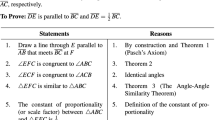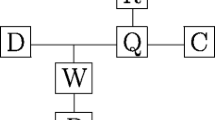Abstract
This paper outlines an epistemological conception which attempts to relate the formal aspects of mathematical proof to its pragmatic dimensions. In addition to the key concept of application, the paper makes use of several concepts from the domain of analytical philosophy, to present a view of proof that might best be categorized as a dialectical one. A number of implications for teaching are discussed.
Similar content being viewed by others
References
Balacheff, N.: 1982, ‘Preuve et d émonstration’,Recherches en Didactiques des Math ématiques 3(2), 261–304.
Balacheff, N.: 1991, ‘Construction et analyse d'une situation didactique’,Journal für Mathematikdidaktik 12(2/3), 199–264.
Bekemeier, B.: 1987, Universitätsmathematik und Schulmathematik in der neuhumanistischen Bildungsreform, Studien zur Wissenschafts-, Sozial- und Bildungsgeschichte 4. Göttingen: Vandenhoeck & Ruprecht.
Bell, A. W.: 1976, ‘A study of pupils' proof-explanations in mathematical situations’,Educational Studies in Mathematics 7, 23–40.
Chazan, D.: 1989,Ways of Knowing: High School Students' Conceptions of Mathematical Proof, Unpublished doctoral dissertation, Harvard University, Cambridge.
Davis, P. J. and Hersh, R.: 1981,The Mathematical Experience, Boston: Birkhäuser.
Dedekind, R.: 1854, ‘Über die Einführung neuer Funktionen in die Mathematik’, in R. Ficke and E. Noether (eds.),R. Dedekind, Gesammelte Werke, Bd. III. New York Chelsea Publishing Company 1969, pp. 428-438.
Dörfler, W.: 1984, ‘Verallgemeinern als zentrale mathematische Fähigkeit’,Journal für Mathematikdidaktik 5, 239–264.
Fischbein, E.: 1982, ‘Intuition and proof’,For the Learning of Mathematics 3(2), 9–18, 24.
Gericke, H.: 1978,Geschichte des Zahlbegriffs, Mannheim: Bibliographishes Institut.
Hankel, H.: 1867,Vorlesungen über die complexen Zahlen und ihre Functionen, Leipzig: Voss.
Hanna, G.: 1983,Rigorous Proof in Mathematics Education, Toronto: The Ontario Institute for Studies in Education, OISE Press.
Jahnke, H. N.: 1978, Zum Verhältnis von Wissenschaftsentiwklung und Begründung in der Mathematik — Beweisen als dikdaktisches Problem, Bielefeld: Dissertation. Materialien und Studien des IDM, Vol. 10.
Kirsch, A.: 1978, ‘Beispiele für “prämathematische ”Beweise’, in W. Dörfler and R. Fischer (eds.),Beweisen im Mathematikunterricht, Wien: Hölder, Pichler, Tempsky, pp. 261–274.
Kolata, G.: 12988, ‘Prime tests and keeping proofs secret’,Science 233, 938–939.
Lakatos, I.: 1976,Proofs and Refutations: The Logic of Mathematical Discovery, Cambridge: Cambridge University Press.
Leibniz, G. W.: 1920, ‘Historia et origo calculi differentialis’, in J. M. Child (ed. and trans.), The Early Mathematical Manuscripts of Leibniz (posthumous work), Chicago/London: The Open Court Publ. Company.
Manin, J. I.: 1977,A Course in Mathematical Logic, New York: Springer.
Newton, I.: 1967, ‘De analysi per aequationes numero temrinorum infinitas’, in D. T. Whiteside (ed.),The Mathematical Papers of Isaac Newton (Vol. II, pp. 206-247), Cambridge. (Original work written in 1669).
Newton, I.: 1687,Philosophiae naturalis principia mathematica, London: J. Streater.
Novy, L.: 1973,Origins of Modern Algebra, Leiden: Noordhoff.
Ohm, M.: 1827, Versuch eines vollkommen consequenten Systems der Mathematik, erster und zweiter Theil, also appeared under the title: Lehrbuch der Arithmetik, Algebra und Analysis. Nach eigenen Principien. Berlin: Reimer.
Ohm, M.: 1827,Versuch einer kurzen, gründlichen und deutlichen auch Nichtmathematikern verständlichen Anweisung, 10–14 jährige Knaben in Untermittelklassen eines Gymnasiums; in obern Klassen einer gelehrten Vorbereitungsschule, desgleichen in höheren Bürger- und technischen Vorbereitungs-Schulen, zu einem leichten, gr ündlichen und wissenschaftlichen Studium der Mathematik f ähig zu machen. Berlin: Rieman.
Peacock, P.: 1830,A Treatise on Algebra, Cambridge: Cambridge University Press.
Richards, J. L.: 1980, ‘The art and the science of British algebra: A study in the perception of mathematical truth’,Historia Mathematica 7, 343–365.
Semadeni, Z.: (n.d.),The Concept of Premathematics as a Theoretical Background for Primary Mathematics Teaching, Warsaw: Polish Academy of Sciences.
Sneed, J. D.: 1971,The Logical Structure of Mathematical Physics, Dordrecht: Reidel.
Stein, M.: 1988, ‘Beweisfähigkeiten und Beweisvorstellungen von 11–13 jährigen Schülern’,Journal für Mathematikdidaktik 9(1), 31–53.
Weyl, H.: 1924, ‘Randbemerkungen zu Hauptproblemen der Mathematik’,Mathematische Zeitschrift 20, 131–150.
Wittmann, E. C. and Müller, G. N.: 1988, ‘Wann ist ein Beweis ein Beweis?’, in P. Bender (ed.),Mathematik-Didaktik: Theorie und Praxis, Festschrift für Heinrich Winter. Berlin: Cornelsen, pp. 237–257.
Author information
Authors and Affiliations
Rights and permissions
About this article
Cite this article
Hanna, G., Jahnke, H.N. Proof and application. Educ Stud Math 24, 421–438 (1993). https://doi.org/10.1007/BF01273374
Issue Date:
DOI: https://doi.org/10.1007/BF01273374




